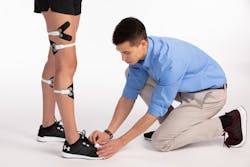New Technology Makes “Moves” in the Medical Industry
The medical industry is finding new solutions every year to combat healthcare cost and provide better care. With new connected and IoT devices, wearables are getting a lot of attention. Technologies are now available with digital platforms that offer a new way to quantify human movement for health and safety.
Firms such as StrongArm Technologies are using technology to track human movement. Its goals are to keep workers or, as CEO and founder Sean Petterson calls them, industrial athletes, safe. One of the company’s products can wirelessly track a workers movements and send notifications if a worker might be overexerting themselves. A connected platform can also suggest taking a break or stretching exercise to reduce the likelihood of injuries and fatigue.
Dr. Nan-Wei Gong is the CEO of the startup FIGUR8. Her company is offering a new technology in wearables that might find its way into helping the medical but, like StrongArm Technologies, could find its way in helping the manufacturing and other industries.
Tracking the human body can be difficult. Fortunately, there are creative researchers such as Gong to find solutions. Movement is not only acceleration, rotation, inertia, etc. Tracking soft tissue like muscle deformation offers a way of quantifying movement, injuries, fatigue, and other factors. However, stretchy ductile materials can present certain challenges.
Accelerometers and gyroscopes can track movement but can’t collect data on soft tissue deformation. This is one of the innovations MIT and Massachusetts General Hospital for five years, and Gong’s company has worked on for the last two-and-a-half years to understand the science, calibrate the sensors, and bringing the technology to market with other partners.
This flexible tracking sensor is entering the market. Gong is looking for collaborators and companies to see just how far this innovative technology could go toward improving healthcare.
Electromyography (EMG) is an electrodiagnostic medicine technique for evaluating and recording the electrical activity produced by muscles. Some exoskeleton and prosthetics have used EMG to see if it is possible to have human electrical signals communicate to mechanical actuators. However, EMG normally needs clean contact with the skin that may require shaving. Additionally, collecting electrical signals from a human body requires a lot of filtering.
Therefore, Gong and researchers used surface-mechanomyography (sMMG) technology instead. Using a conductive, stretchable polymer that can measure impedance was able to track surface deformation. This technology can also be attached quickly and easily without the need to clean or shave the area. As the patient moves the polymer stretches and software can use the change in impedance to determine the deformation of soft tissue.
Gong says elite athletes and physical therapy offices could use this technology to create a baseline for patients and track performance overtime. FIGUR8 has devised movements to engage different muscle groups that can generate reports indicating performance and any progression. This might allow an athlete to track their flexibility, an older patient to track joint mobility, or a warehouse worker to limit fatigue and injury. Ultimately, tracking movement with soft tissue deformation offers a quantifiable tool for doctors to track movement and document it overtime.
This solution uses accelerometers, inertial measuring units, gyroscopes, magnetometers, and the surface deformation sensor in a wireless package that can be applied and taken off easily. Gong say the technology is new, but has the potential to move outside of physical therapy offices and into other industries.
With worker data such as StrongArm is using and new technology such as what FIGUR8 has brought to market athletes, workers, the elderly, and others could get real-time reports, notifications, and even workout suggestions to keep the human body moving in a healthy direction.


